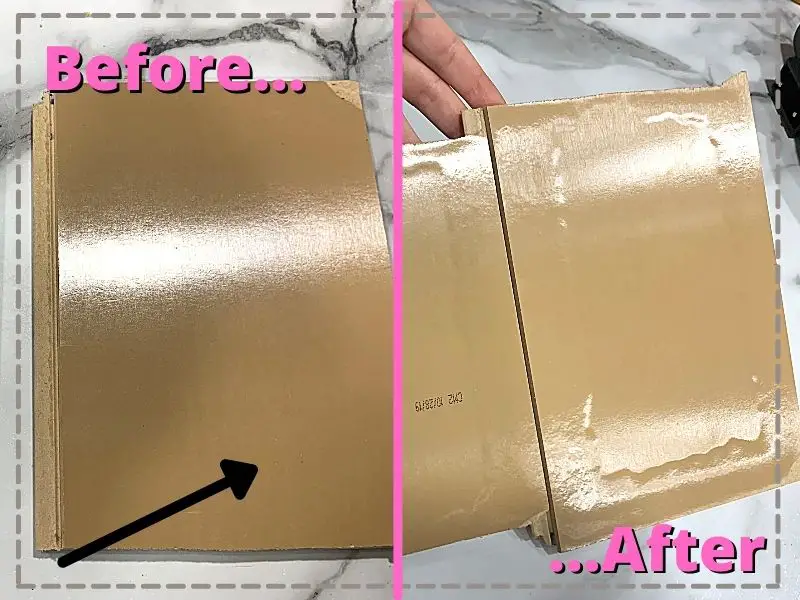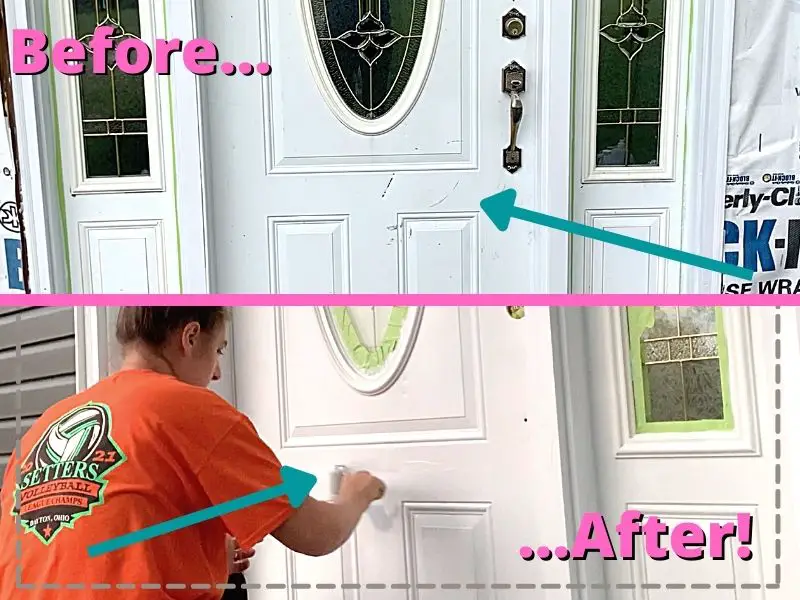*My posts may contain affiliate links, which means I may receive a small commission, at no cost to you, if you make a purchase through a link! Thank you for supporting my website!*
Last updated on March 4th, 2024 at 01:23 pm
Have you ever wondered how much water laminate flooring can take before it starts to see irreparable damage? Well, I did too, so I decided to run a little experiment to help me better answer that question.
I found exactly how long laminate flooring can be underwater before seeing damage from my experiment. Here is what I found:
Laminate flooring can take small, everyday spills on top of the flooring without seeing any water damage. However, if laminate takes on as much water as a major leak or flood, the flooring will resist water damage for only 2-4 hours. By the 5th hour submerged, laminate will start to swell and be irreparable.
Now that I’ve fully tested my theory, I have a better understanding of the true likelihood that my laminate flooring will ever see major water damage. (Luckily, the odds are in our favor.)
Below, I broke down my findings and how I ran the test (I timed it for real results), so you can determine whether your laminate flooring can be salvaged or not.
Let’s dive in!
Quick Navigation: Length Of Time For Laminate To Sit Underwater Before Damaging
- Does Laminate Get Damaged By Water?
- Laminate Floor Water Damage Results
- Amount Of Water
- Length Of Time
- Amount Of Damage
- What Happens When Laminate Flooring Gets Wet?
- Other FAQs About How Much Water Laminate Flooring Can Take
- Final Thoughts
Does Laminate Get Damaged By Water?
Laminate flooring is durable enough to handle everyday spills without damage. Water will pool on top of the laminate and evaporate before causing damage. If water gets underneath for multiple hours, laminate will swell and need replacing.
It’s pretty common to put laminate flooring in bathrooms because of how sleek and modern it looks (even we did that in 3 bathrooms we’ve remodeled).
But knowing water could damage the flooring, I was curious as to how much water laminate can truly take before the bulk of the water damage is done.
So that led me to this experiment.
From what I found, laminate flooring is pretty durable from normal water spills (even in a bathroom or kitchen area).


However, it’s when the water gets under the laminate and sits, the damage I’ll describe below occurs. That’s promising, in my opinion, because I don’t have to worry about the laminate in my bathrooms or by my kitchen sink.
I only have to worry if a major leak happens. (This did happen in our laundry room while we were renovating and we were able to minimize the damage and save the floor. You can see how we did that in my tutorial here.)
Laminate Floor Water Damage Results
To test how much water laminate flooring can take, I started by pouring 1/4 cup of water on top of two “clicked together” pieces of flooring and letting it sit.
I wanted to see how well laminate can handle the small, everyday type of spills to see how waterproof it actually is.

After that, I fully submerged both boards (that had cut edges, uncut tongues, and one “clicked together” seam) underwater and set a timer to see how long it would take for water damage to set in.
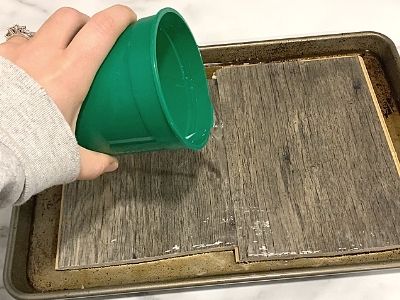
Now, since I knew this laminate flooring is waterproof, I was expecting it to hold off water damage for at least 24 hours. However, my results were surprising.
Here are the results that I found.
| Amount Of Water | Length Of Time* | Amount Of Damage |
|---|---|---|
| 1/4 cup poured on top | 24 hours | None, all water evaporated within this timeframe |
| Submerged in water | 1 hour | None visible |
| Submerged in water | 2 hours | None visible |
| Submerged in water | 5 hours | None visible on top, small amounts of swelling visible underneath |
| Submerged in water | 12 hours | Small amounts of swelling visible on top, all edges and seams swollen underneath |

Laminate Flooring Used In My Experiment
For my test, I used the laminate flooring that we installed throughout our entire home, Mohawk PerfectSeal Laminate Flooring in Lawson Grey Oak found at Menards.
We’ve had this flooring installed for just over two years, and so far, it’s made it through an accidental flood, tons of walking, furniture being dragged across it, and the occasion cat-spaz-attack (you know where they sprint through the house and look like a cartoon character because they can’t get any traction while they run… sigh).
The only part that has seen any damage is the area where I accidentally dropped a sharp-cornered piece of a treadmill on it while carrying the treadmill inside (oops). Other than that, I’m happy with the durability of laminate flooring compared to the cost.
Now, let’s dive into the results a little further, so you can see pictures of the damage for yourself!
Amount Of Water
To determine how much water laminate flooring can take before seeing water damage, I poured about a 1/4 cup of water on top of two clicked-together pieces of laminate and started my timer.
This test was meant to mimic the small, everyday spills that laminate flooring sees throughout its lifespan. This amount of water is on top of the floor and should never get beneath it because the locking mechanism is made to prevent water from seeping into the seams.
After that amount of water fully evaporated, I put my test pieces of laminate in a baking tray, poured water in until all pieces and edges were fully submerged underwater, and started my timer.
This test was meant to mimic laminate flooring that’s been submerged underwater for a period of time from a flood or major water leak. This amount of water is on top of and underneath the laminate flooring.
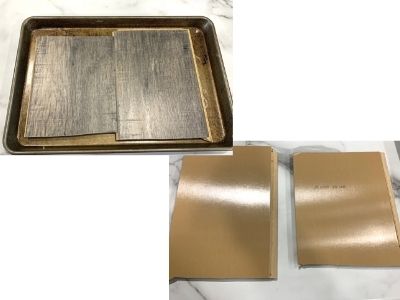
Length Of Time
The next thing I did to determine how much water laminate flooring can take before seeing damage was to periodically look for water damage.
My test times were as follows:
- Small amount (about 1/4 cup) of water poured on top until it evaporated (about 24 hours)
- 1 hour fully submerged
- 2 hours submerged
- 5 hours submerged
- 12 hours submerged
- 12 hours air-dried after being submerged for 12 hours
- 24 hours air-dried after being submerged for 12 hours
Amount Of Damage
Finally, when my timer went off, I analyzed the top, bottom, seam, and edges of the laminate to determine how long laminate flooring can be underwater before it sees significant damage.
Some of my results were kind of surprising, while others were to be expected.
Small Spill On Top For 24 Hours
As expected, the laminate flooring did its job and kept the spill on top of the flooring. The way that the seams lock together prevents water from seeping between them.
This feature is crucial to have in laminate flooring because without it, water would easily get underneath the flooring and cause swelling and damage even from the smallest spill.
So if you’ve had a few minor spills on your laminate flooring over the years, no need to worry. The flooring is most likely doing its job to prevent water from getting underneath.
However, I still recommend wiping up any spills because ultimately, that’s the best way to completely prevent water damage from happening.

Submerged For 1 Hour
After an hour of being submerged, there was no noticeable damage or swelling.
If the laminate is underwater for this short period of time, it is still possible to save it from any water damage.

Submerged For 2 Hours
After being submerged underwater for two hours, the laminate flooring still shows no sign of water damage.
Although, with every hour that passes, the cut edges and exposed tongues get darker in color. This suggests that they’re taking on more and more water as time passes.
When pressed on, however, neither the tongues nor the boards themselves feel squishy or damaged. (In fact, they felt as hard as if they were still dry.)
If the laminate is underwater for this period of time, it is still possible to save it from any water damage. However, the window to save the flooring is getting smaller.
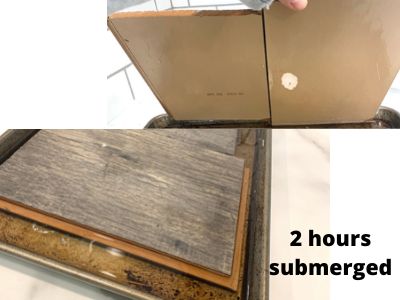
Submerged For 5 Hours
After 5 hours of being submerged, water damage is still not noticeable on top of the flooring. However, significant damage is starting to occur on the bottom.
All of the edges (even along the seams) are starting to swell and become damaged.
If the laminate is underwater for this period of time, it is still possible to save it from noticeable water damage on top. However, water damage has taken place on the bottom.
This small amount of damage shouldn’t be noticeable once the flooring is dried out for years, however, it can cause the laminate to have a shorter lifespan than it should.
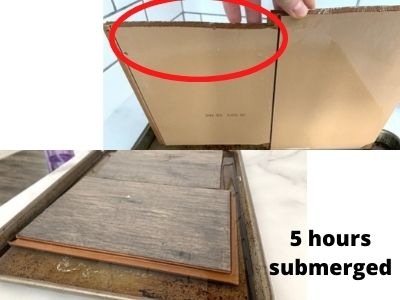
Submerged For 12 Hours
After 12 hours of being submerged, water damage is now noticeable on top of the flooring and on the bottom.
All of the edges (even along the seams) are swelling significantly and becoming permanently water damaged.
If the laminate is underwater for this period of time, some water damage is probably noticeable on the top and depending on how severe, maybe cannot be salvageable at all.
This damage on the top of the board will still be noticeable even after the flooring is dried out. And whatever amount of damage you can see, just know that there is worse damage underneath.


Air Dried For 12 Hours
After the boards were submerged for 12 hours, I was curious if the swelling would go away once it dried out.
So I pulled the pieces out of the water, towel-dried them off, then let them air dry for another 12 hours.
After 12 hours, the swelling on the top and bottom of the boards was still visible. After drying out, the water damage did not go away.

Air Dried For 24 Hours
After air-drying for a full 24 hours, the boards still showed the same amount of swelling and water damage on the top and the bottom.
This shows that once water penetrates the boards, the damage is irreversible.
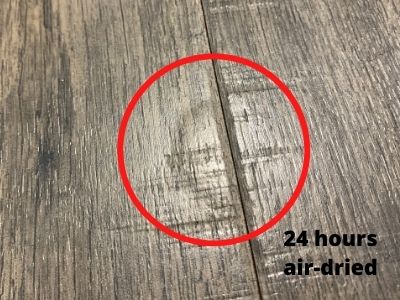
That concluded my experiment! I was happy to see that the small, normal spills didn’t affect the laminate at all.
It’s also good to know that even if a large leak happens, laminate can be saved from water damage if it’s dried out within a 4-hour timeframe.
What Happens When Laminate Flooring Gets Wet?
From this experiment, here’s what I found:
One: Laminate Flooring Will Swell
The main problem that occurs when laminate flooring gets wet underneath is that it swells.
Laminate can take be submerged underwater for 2-4 hours before seeing significant water damage because it has a coating to protect the soft interior part of the board.
However, as time passes and the boards continue to sit underwater, the water seeps through the tongues, grooves, and cut edges of the planks and fills the soft interior part and the tongues with water.
Surprisingly, even after sitting underwater for over 24 hours, the tongues still feel pretty strong, however, once they swell, they don’t ever return to their normal shape (even after they’re completely dried out).
Wet, swollen laminate flooring is problematic because the tongues will remain swollen indefinitely. When the tongues are swollen, they cause gaps in the seams and can’t adequately lock together anymore. The boards will have to be replaced with new ones that have new tongues to fix this problem.
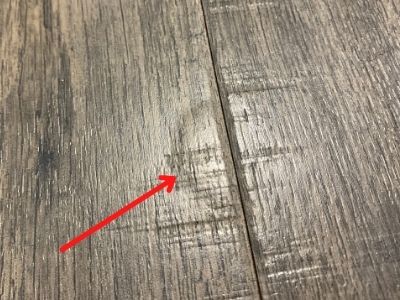
Two: The Edges Of Wet Laminate Flooring Can Curl
In extreme cases, the next problem that occurs when laminate flooring gets wet is that its edges can start to curl up.
The thickest, most water-resistant part of laminate flooring is the top layer of the board. This layer is what helps most spills pool, so you can easily clean it up.
However, when water absorbs under this top layer, the edges of this layer can start to curl up.
Not only does this curling look bad, but it also causes the top layer to break off at the corners once the boards have dried out and are walked on.
And once the corners have broken off, those broken areas are just another spot where more water can penetrate the board and cause some of the other issues listed in this article.
This can also happen on the bottom protective layer, although, you most likely will never see that part break off.

Three: Wet Laminate Flooring Can Fade In Color
The next problem that occurs when laminate flooring gets wet is that it can start to fade in color.
Water damage always seems to find a way to make items fade in color and laminate flooring is no exception.
You’ll most likely notice water damage by either the spongy feeling when you walk or by the fading color in certain spots on your floor.
This problem usually occurs over many years, though. Oftentimes, it will happen around exterior doors that haven’t been properly protected with a doormat.
That constant tracking of rain and snow inside the house can cause this fading to occur in the most heavily-trafficked areas.
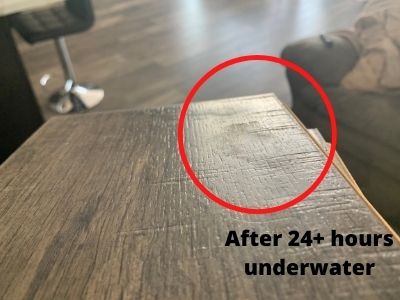
Four: Mold Can Grow Under Wet Laminate Flooring
The final problem that can occur when laminate flooring gets wet is that it can start to grow mold and mildew underneath it.
While most underlayment and laminate floors are mold and mildew-resistant, they can still suffer from this annoying growth if a lot of water gets trapped between the two layers.
Once mold starts to grow because of water damage within the flooring, you will likely have this problem forever until the affected floorboards are replaced.
This is because you will have a hard time cleaning and killing the layer of mold and mildew beneath the boards without removing them entirely.
So once you see some mold growth on top of your laminate flooring, that’s a strong sign that there’s much more growth and damage underneath that you can’t see, and it’s time to replace the flooring.

Other FAQs About How Much Water Laminate Flooring Can Take
Here are some other frequently asked questions about laminate flooring water damage to help you decide whether your wet flooring can be saved or not!
Will Laminate Floor Swelling Go Down?
Once any water has penetrated through the protective layer on laminate flooring and caused swelling, the swelling will not go down even after the flooring has dried out. The only way to repair swollen laminate is to replace the damaged planks with new ones.
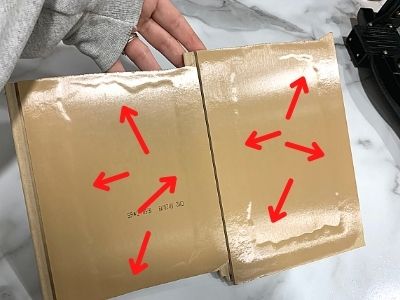

Will Wet Laminate Floorboards Dry Out?
Wet laminate floorboards will eventually dry out on their own, but potentially after water damage has already occurred. To help wet laminate dry out faster and potentially prevent water damage, set up fans and dehumidifiers to remove excess water.
Can You Seal Laminate Flooring To Make It Waterproof?
Some laminate flooring is waterproof, so it does not need to be sealed to make it waterproof. However, you can apply some caulk in the seams and along any shower or tub bases to help water from getting underneath and causing damage.
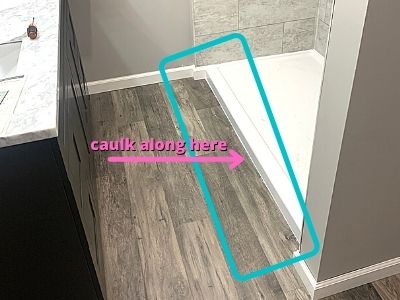
How Do You Save Laminate Flooring From Water Damage?
If you act quickly, you can save laminate flooring from major water damage (even if it’s been in a flood.
I have a full tutorial on how to save wet laminate flooring. Check that tutorial out here.
Final thoughts On Laminate Flooring Water Damage
There you have it! Now you can confidently determine the damage done to any laminate flooring that sees a large amount of water for any length of time.
Having that knowledge gives you power! Power to act quickly and potentially save thousands of dollars from avoiding water damage.
Catch you in my next post!
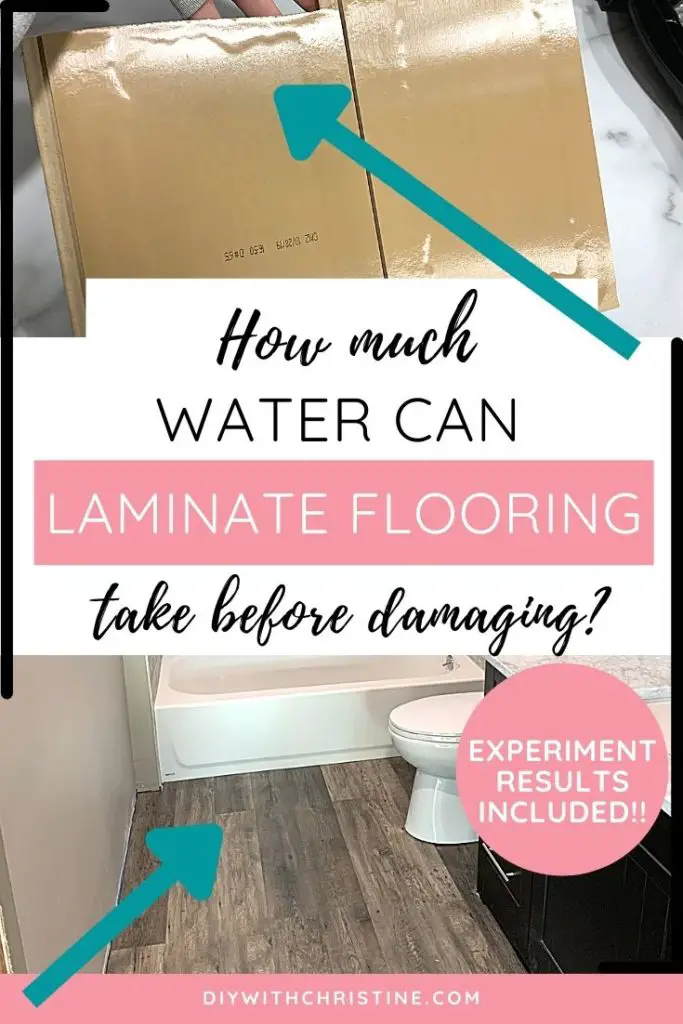

By Christine
Christine is a blogger and DIYer who tackles home renovation and decorating projects alongside her husband, Adam, for their personal residence and rental properties. Although she successfully tackles large renovation projects to avoid expensive contractor fees and bring her vision to life now, her path to success was not easy.
Go here to read her story, “From a Clueless First-Time Homebuyer To A Confident DIYer Creating Her Dream Home One Project At A Time“.
Popular Posts
DIY With Christine is a participant in the Amazon Services LLC Associates Program, an affiliate advertising program designed to provide a means for sites to earn advertising fees by advertising and linking to Amazon.com.

